Search results for: Mckinsey 7s
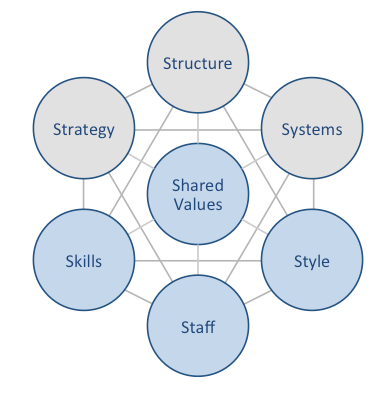
Square McKinsey 7S model is intended to illustrate how seven elements of business can be aligned to increase effectiveness. The framework divides business elements into two groups – hard and soft. Strategy, structure and systems are considered hard elements, whereas shared values, skills, style and staff are soft elements. According to Square McKinsey 7S model, there is a strong link between elements and a change in one element causes changes in others. Moreover, shared values are the most important of elements because they cause influence other elements to a great extent. McKinsey 7S model Hard Elements in Square McKinsey 7S Model Strategy Square business strategy is based on principles of simplifying financial transactions and developing an ecosystem of financial products and services. The financial services platform has two types of ecosystem – seller ecosystem and cash ecosystem. Square systematically expands both ecosystems with addition of new financial products and services that simplify processes and challenge the status quo. Structure Square organizational structure is highly dynamic, reflecting the rapid expansion of the range of financial products and services offered by the finance sector disruptor. Although it is difficult to frame Square organizational culture into any category due to the complexity of the business, it is closer to flat organizational structure compared to known alternatives. Specifically, co-founder and CEO Jack Dorsey has very little tolerance for bureaucracy and formality in business processes. Moreover, Dorsey believes in providing independence to teams and maintain the team sizes small. All of these are reflected in Square organizational structure. Systems Square Inc. business operations depend on a wide range of systems. These include employee recruitment and selection system, team development and orientation system, transaction processing systems and others. Moreover, customer relationship management system, business intelligence system and knowledge management system is also important…
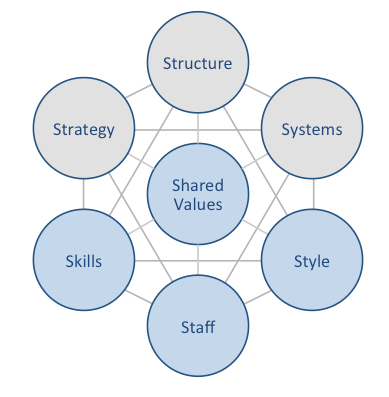
Uber McKinsey 7S model illustrates the ways in which seven elements of businesses can be aligned to increase effectiveness. According to the framework strategy, structure and systems represent hard elements, whereas shared values, skills, style and staff are soft elements. McKinsey 7S model stresses the presence of strong links between elements in a way that a change in one element causes changes in others. As illustrated in figure below, shared values are positioned at the core of Uber McKinsey 7S model, since shared values guide employee behaviour with implications on their performance. McKinsey 7S model Hard Elements Strategy Uber pursues cost leadership business strategy. The ride-hailing giant gains cost advantage thanks to internet-based nature of its business model that disrupted traditional taxi industry in the global scale. The international transportation technology company increases range of its services regularly to cater for the needs of greater numbers of customers. Moreover, Uber business strategy places a great emphasis on a high level of user convenience. Growing the business through acquiring adjacent businesses is another important aspect of Uber business strategy. Structure Uber organizational structure can be classified as hierarchical. Accordingly, the company is disadvantaged by the shortcomings of hierarchical structure such as ineffective communication across various departments, rivalry between departments that may compromise long-term growth prospects and high level of bureaucracy. Following the failed IPO in 2019, the CEO Mr. Khosrowshahi changed Uber organizational structure to increase his role in operational day-to-day management. As part of these changes, the positions of chief operating officer (COO) and chief marketing officer (CMO) were also eliminated. Systems Systems within McKinsey 7S model refer to daily activities and procedures that Uber staff use to provide ride-haling services to millions of customers worldwide. There is a wide range of various systems that are important for Uber’s long-term…
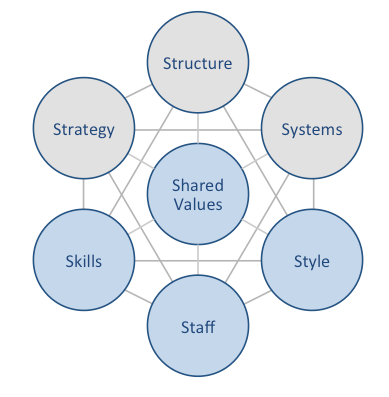
Tesla McKinsey 7S model illustrates the ways in which seven elements of businesses can be aligned to increase effectiveness. According to the framework strategy, structure and systems are considered as hard elements, whereas shared values, skills, style and staff represent soft elements. McKinsey 7S model stresses the presence of strong links between elements. Specifically, according to this framework, a change in one element causes changes in others. As it is illustrated in figure below, shared values are positioned at the core of Tesla McKinsey 7S model, since shared values guide employee behaviour with implications on their performance. Figure 11 McKinsey 7S model Hard Elements Strategy Tesla business strategy is based on the focus on electric cars driven by company’s mission to accelerate the world’s transition to sustainable energy. The alternative fuel vehicles manufacturer pursues product differentiation business strategy. Tesla cars and energy products are differentiated on the basis of performance, design and environmental sustainability. Moreover, ownership of distribution via company-operated stores and galleries in shopping centres and other places is placed at the core of Tesla business strategy. Moreover, the alternative fuel vehicles manufacturer positions low costs of Tesla electric vehicles ownership as one of the solid bases of competitive advantage. Structure It is difficult to classify Tesla organizational structure into a single category due to its unique nature. Inability or unwillingness of CEO Elon Musk to delegate key tasks has certain implications on organizational structure of the company. Specifically, Musk has more people directly reporting to him than any other auto company and turnover amongst Tesla senior executive team is high. Moreover, there is no organizational chart or public list of senior leaders at Tesla. Nevertheless, Tesla organizational structure is closer to divisional structure compared to other known structures. The operations of the electric automaker are divided…
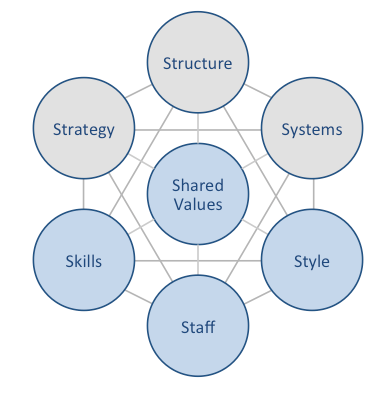
Apple McKinsey 7S model illustrates the ways in which seven elements of businesses can be aligned to increase effectiveness. According to this model, strategy, structure and systems represent hard elements, whereas shared values, skills, style and staff are soft elements. McKinsey 7S framework stresses the presence of strong links between elements in a way that a change in one element causes changes in others. As it is illustrated in figure below, shared values are positioned at the core of Apple McKinsey 7S framework, since shared values guide employee behaviour with implications in their performance. Apple McKinsey 7S model Hard Elements in Apple McKinsey 7S Model Strategy Apple pursues differentiation business strategy with a particular focus on the design and advanced features and capabilities of products. The company aims to benefit from the first mover advantage to a maximum extent as it was the case with introduction of iPod, the first device of its kind that stored thousands of songs with simple shuffle capabilities through songs and the development of Macintosh, the first computer to use a graphical user interface. Accordingly, Apple products and services are generally more expensive compared to the competition. Moreover, Apple business strategy involves the creation of a sort of closed ecosystem, where it’s various devices and software sync easily and work well with each other. Advantages the company gains from this strategy include high switching costs for customers and this provides the opportunities to leverage relationships with existing customers to offer other products and services. Furthermore, the multinational technology company has developed a strategy to reduce dependence of the business on the sale of iPhones. This strategy involves putting greater emphasis on services divisions of the business and more investments on research and development of new products and services. The iPhone maker has also specified…
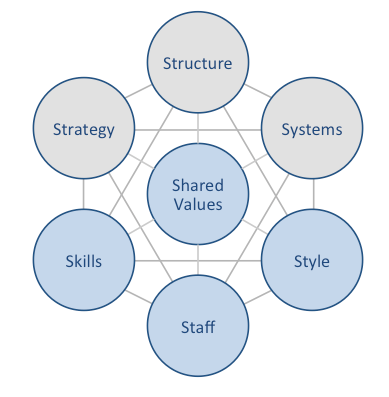
W.W. Grainger McKinsey 7S model illustrates the ways in which seven elements of industrial distribution business can be aligned to increase the overall effectiveness. The framework specifies strategy, structure and systems as hard elements, whereas shared values, skills, style and staff are considered as soft elements. According to McKinsey 7S model, there are strong links among elements in a way that a change in one element causes changes in others. As it is illustrated in Figure 7 below, shared values are positioned at the core of Grainger McKinsey 7S model. This is because shared values guide employee behaviour with implications on their performance. W.W. Grainger McKinsey 7S model Hard Elements in W.W. Grainger McKinsey 7S model Strategy Grainger pursues differentiation business strategy. The B2B distributor differentiates itself in the market by offering the widest range of MRO products. Specifically, Grainger offers about 1,7 million types of products supplied by about 5000 suppliers worldwide.[1] Moreover, the differentiation strategy pursued by the industrial supply company also relates to inventory management, technical support and differentiated sales and services. Structure Grainger has an hierarchical organizational structure with Chairman and CEO DG Macpherson sitting at the top of the hierarchy. The B2B distributor had a major restructuring in 2013 in Americas business segment. Moreover, taking into account growing competition from Amazon business, increasing integration of internet of things into industrial distribution practices and other changes in external business environment, it can be argued that Grainger organizational structure may change in the medium term perspective. It can be forecasted that changes in Grainger’s corporate structure will be directed in increasing the flexibility of the business so that it can react to changes in external marketplace more effectively. Systems There is a wide range of business systems that keep MRO products distribution at the global marketplace…
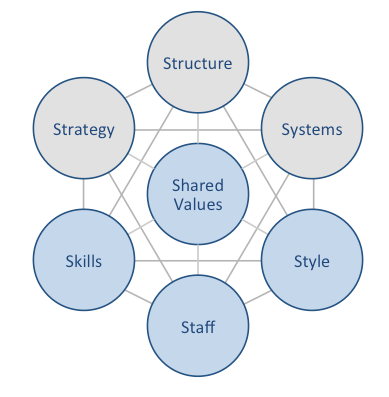
Airbnb McKinsey 7S model illustrates the ways in which seven elements of businesses can be aligned with positive implications on the overall effectiveness of the business. According to this framework strategy, structure and systems are grouped as hard elements, whereas shared values, skills, style and staff are considered soft elements. According to McKinsey 7S model, there are strong links between individual elements. Specifically, a change in one element causes changes in others. As it is illustrated in figure below, shared values are positioned at the core of Airbnb McKinsey 7S model; they guide employee behaviour with implications on their performance. Airbnb McKinsey 7S model Hard Elements in Airbnb McKinsey 7S model Strategy. Airbnb business strategy is associated with platform business model and accordingly, instead of owning the services it offers, the company engages as a broker between suppliers and consumers, receiving a commission of 9% to 15%. Moreover, increasing level of technological integration into various aspects of the business can be specified as one of the critical features of Airbnb business strategy. The global hospitality service brokerage company also places its community and trust among organizational stakeholders at the forefront of its business strategy. Structure. Airbnb organizational structure can be classified as matrix. The workforce is divided into teams of up to 10 people. Importantly, teams support each-other to a great extent. Team leaders and members feel free to ask other teams if they need resources or capabilities. Airbnb organizational structure can be also branded as holocratic, because decision making power is given to teams throughout organization to a great extent and majority of teams are self-managed. The corporate structure of Airbnb is highly dynamic due to rapidly increasing scale of the business worldwide. Systems. Airbnb business operations depend on a wide range of internal systems such as employee recruitment and…
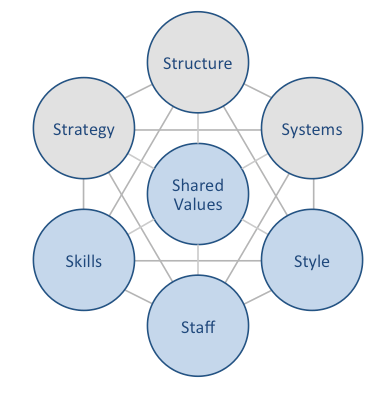
Microsoft McKinsey 7S model shows how seven elements of businesses can be aligned to increase effectiveness. According to this framework, strategy, structure and systems represent hard elements, whereas shared values, skills, style and staff are soft elements. McKinsey 7S model stresses the presence of strong links between elements in a way that a change in one element causes changes in others. As it is illustrated in figure below, shared values are positioned at the core of Microsoft McKinsey 7S model, since shared values guide employee behaviour with implications in their performance. Microsoft McKinsey 7S model Hard Elements in Microsoft McKinsey 7S Model Strategy. Microsoft business strategy can be classified as product differentiation. The company develops advanced technology products and services and sells them for premium costs. Moreover, Microsoft business strategy is currently focused on “cloud-first, mobile-first”, growth through mergers and acquisitions and exploring business opportunities related to augmented and virtual reality. As the latest addition to its business strategy, the multinational technology company is focusing on the concept of ‘tech intensity’, which aims to position Azure as the worlds’ computer with evident positive implications on the long-term growth prospects of the business. Structure. Microsoft organizational structure is divisional and such a structure resulted from a restructuring initiative introduced by CEO Satya Nadella in 2015. Microsoft engineering group is divided into three divisions: Cloud and AI Group, Experiences + Devices and Artificial Intelligence and Research. Business functions, on the other hand, are divided into nine divisions. Microsoft corporate structure is highly dynamic and ever-evolving to meet the demands of changing external market place. Systems. There is a wide range of systems that are critically important to run Microsoft successfully. These include employee recruitment and selection system, team development and orientation system, transaction processing systems, customer relationship management system, business…
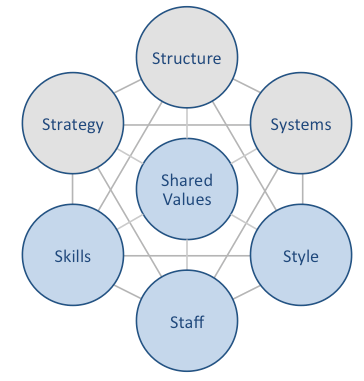
Xiaomi McKinsey 7S model illustrates the ways in which seven elements of businesses can be aligned so that overall effectiveness can be increased. According to the framework strategy, structure and systems are hard elements, whereas shared values, skills, style and staff are considered as soft elements. McKinsey 7S model stresses the presence of strong links between elements in a way that a change in one element causes changes in others. As it is illustrated in figure below, shared values are positioned at the core of Xiaomi McKinsey 7S model, since shared values guide employee behaviour with implications in their performance. Xiaomi McKinsey 7S Model Hard Elements Strategy. Xiaomi business strategy is based on cost leadership. Company’s business strategy also integrates gathering and utilising a large fan base and aggressively increasing the ecosystem of products and services. Moreover, Xiaomi positions itself as an internet and software company rather than a hardware company. Accordingly, the sales of hardware are perceived as a means to deliver software and services in the long-term perspective. Structure. Xiaomi has a matrix organizational structure. The electronics and software company has various business units that are managed independently. Xiaomi organizational structure can also be also classified as flat. Despite its large size employing more than 18000 people in 70 countries, the company has only a few layers of management. Systems. Xiaomi’s business depends on a wide range of systems such as employee recruitment and selection system, team development and orientation system and transaction processing systems. Moreover, there are critically important systems for the company such as customer relationship management system, business intelligence system, and knowledge management system. The mobile internet company aims to increase the efficiency of these and other systems via the integration of internet-based information technologies. Xiaomi Inc. Report contains a full analysis…

Google McKinsey 7S model illustrates how seven business elements can be aligned to increase effectiveness. Strategy, structure and systems are hard elements, whereas shared values, skills, style and staff represent soft elements. McKinsey 7S model attempts to illustrate that a change in one element causes changes in others. As it is illustrated in figure below, shared values are positioned at the core of Google McKinsey 7S model, since shared values guide employee behaviour with implications in their performance. Google McKinsey 7S model Hard Elements Strategy. Google core business strategy is business diversification and introduction of new products and services in a regular manner. Google business strategy is also based on the development of a closed eco-system to motivate customers to use greater range of products and services. Customers usually enter this ecosystem through using Chrome browser, watching YouTube videos or using Gmail. In no time, they are prompted to use additional services such as Drive, Play, Calendar, Blogger and others. Alphabet Inc., Google’s parent company also uses acquisitions business strategy extensively and more than 200 companies and 30 acquisitions were made in 2015 and 2016 alone. Structure. Google was restructured in 2015 to become a wholly owned subsidiary of a newly established parent company Alphabet Inc. Under the new structure, the company is divided into a number of divisions and each division is positioned as a separate brand such as Google, Calico, Nest, Access (Fiber) and others. The new structure helps the company to move beyond search engine business and to engage in diversification strategy to a greater extent. Systems. Google operations rely on a wide range of systems such as employee recruitment and selection system, team development and orientation system, transaction processing systems, customer relationship management system, business intelligence system, knowledge management system and others. Additionally, ranking of web-pages…
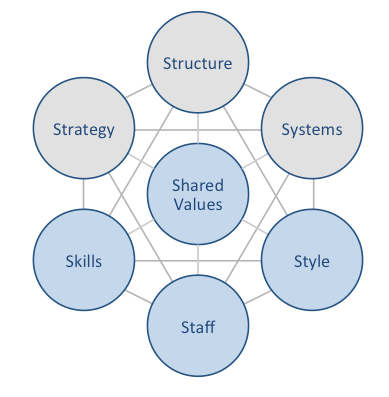
Samsung McKinsey 7S model attempts to explain how seven individual elements of the business can be aligned to increase effectiveness. According to this model strategy, structure and systems represent hard elements, whereas shared values, skills, style and staff are soft elements. McKinsey 7S model argues that there are strong links between elements in a way that a change in one element causes changes in others. As it is illustrated in figure below, shared values are positioned at the core of Samsung McKinsey 7S model, since shared values guide employee behaviour with implications in their performance. Samsung McKinsey 7S model Hard Elements Strategy. Samsung business strategy is mainly based on market readership, i.e. replicating innovations made by market leaders in terms of introducing new products and/or adding innovative features to new products. Samsung’s major competitor, Apple can be specified as company Samsung mainly replicates from. Moreover, Samsung business strategy is based upon scanning and utilising opportunities in the market and new product development on a regular basis. Structure. Samsung organizational structure is divisional and the company is divided into three divisions on the basis of products: IT & Mobile Communications (IM), Consumer Electronics (CE), and Device Solutions (DS). Each division is managed separately according to unique aspects and characteristics of its products. As the outcome of review of optimal organizational structure completed on April 2017, the senior management decided not to shift to holding pattern of organizational structure. Nevertheless, Samsung organizational structure may change in medium term perspective. This is due to a series of scandals the company had to deal with recently, including the imprisonment of Jay Y. Lee, a former Samsung executive and founding family member for his role in bribery and embezzlement. Systems. Samsung’s long-term growth prospects depend on smooth running of a wide range of systems. These…
